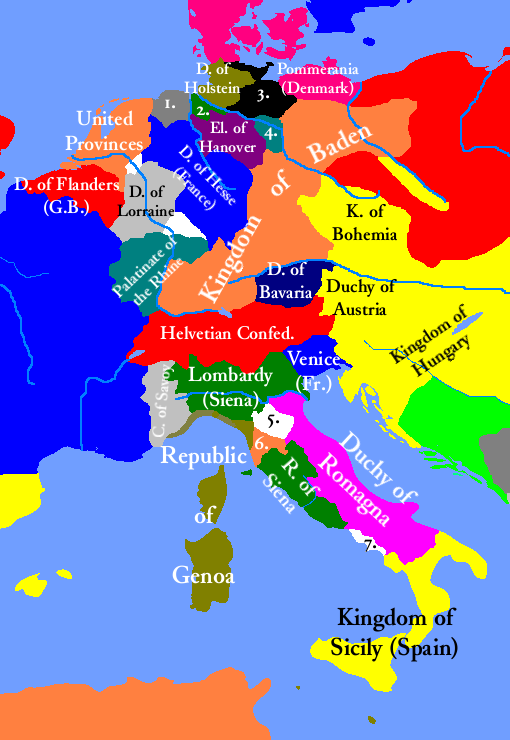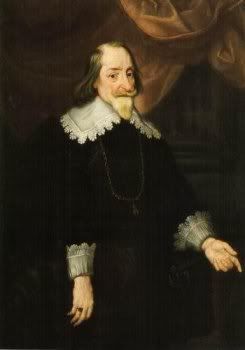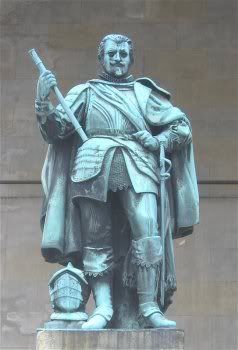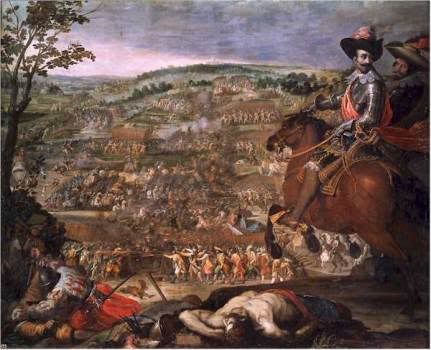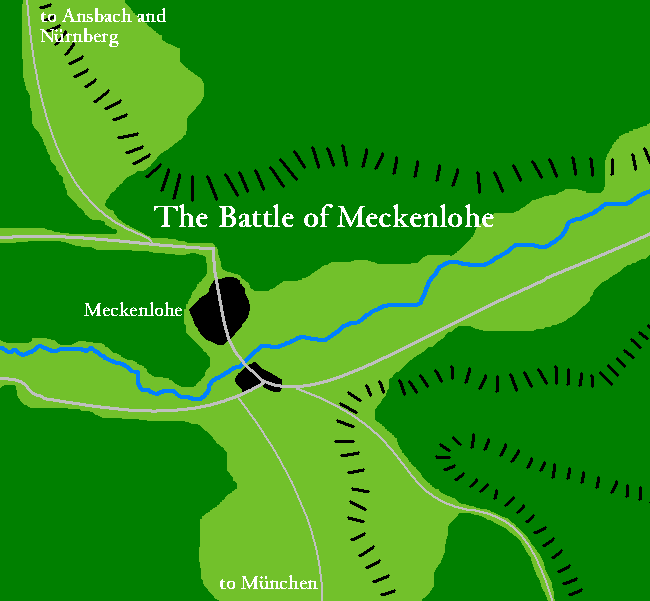While these expeditions were going on outside of Europe, James began to take a much larger interest in the continent. The old alliance with the Dutch and Baden was renewed in 1611, now called the Evangelical League. Theoretically, it was opened to all nations opposed to the Catholic powers of Austria, France, and Spain; however, none of the others were particularly interested, as Poland was too busy opposing Russia, and Finnland was dealing with a surprisingly strong Swedish defence.
At this time, tensions between Catholics and Protestants were at a high not only in Britain but in the rest of Europe. The French Wars of Religion had not completely ended, and there was still a simmering conflict between the northern and southern parts of the country. Austria was dealing with Swiss expansion in the Tirol region, while Germany proper had been shocked by the collapse of the Duchy of Lorraine. In a last-minute attempt to spite the Protestants, the Duke managed to secure the election of Louis VIII of France as Holy Roman Emperor. Instead of restoring a measure of Catholic control over the region, however, this caused most of the Protestant countries to simply refuse to accept his authority, and declare an interregnum.
The Pope was unable to have much of a part in these proceedings; the republic of Siena had seized Rome, and locked the Pope into St. Peter's. This simply threw the Catholic side into turmoil, while the Protestant side did not have an offical leader to organise them. Thus, neither was able to make much of an offensive, only adding to the tension. It seemed only a matter of time before this would be released.
At first, the Evangelical League decided to shore up Protestant control in Germany. To this end, King Georg Friedrich of Baden accepted a letter from the Protestant population of Munich, asking for him to become Duke of Bavaria. Two counts signed this letter, adding some political legitimacy to it; they immediately fled Munich and went to the King's local court in Nuremberg, setting up a "government in exile" for the new appendage to Georg Friedrich's kingdom. The actual reason for this show was to occupy a good strategic position from which to sieze Salzburg (or to aid the Swiss in doing so) and thus end any Austrian hope to project power northward.*
Maximilian von Wittelsbach, Duke of Bavaria, in a contemporary portrait
The war officially began in June of 1616. However, the King of Baden soon found a strong opponent in Duke Maximilian of Bavaria, who used his country's mountainous terrain to devastating advantage. Soon, he was even threatening Nuremberg itself. In what appeared good fortune for the League, the British army made its way as quickly as possible southward in order to restore the situation.
However, this speed was vastly limited by geography. The direct route was blocked off by the French lands of Hesse, and the remnants of the Duchy of Lorraine. The British army would have to march
north out of Flanders, through the Dutch territories, and only then march south through the land of the Elector of Hannover. This they eventually did, and only arrived in Bavaria a full year after the war began.
The leader of this army was Johan 't Serclaes, Count of Tilly, a Flemish nobleman who had made his name in all the various conflicts the Army of Flanders had taken part in, beginning with the sack of Cologne under Queen Elisabeth. His military ability caused great admiration from both superiors and enemies alike, allowing the former to conveniently ignore the fact that he was from a not-so-secretly Catholic family. Whatever his religion, his appearance greatly encouraged the forces of the League in the region, and they went again on the offensive.
Statue of Tilly in Brussels
Tilly himself decided to strike on the Bavarian army threatening Nuremberg. Although said army had less than 10,000 men, it had held off the best that the King of Baden could throw at it. Tilly arrived in Ansbach on 23 June 1617, forcing said army to cease its advance and take up a defensive position a few hundred meters south of the town of Meckenlohe. Tilly advanced to this position and prepared to give battle on 3 July.
The two armies faced off along a large stream flowing between heights on either side. The Bavarians occupied the southern heights; the northern ones were too far away to be of any use to Tilly, and in any case he needed to take the fight to the Bavarians. Since the thick forests around him did not give him much room in which to deploy, he needed to cross the stream in order to make a full attack. Such a proposition was tricky, as the stream was not too far way from the Bavarian positions, and crossing a body of water under fire would be a losing proposition.
Tilly very carefully ordered his units to cross from right to left, as his right flank was the furthest from the Bavarians, and there was a bridge there to aid crossing. Soon, the majority of his right wing was across, though Tilly wished for it all to be before making the attack. However, the commander of the left wing, John Erskine (heir to the Earl of Mar), apparently did not agree with this idea and launched the attack early.
The Victory of Meckenlohe, by Vicente Carducho (1622).
Instead of crossing the stream in a more orderly fashion and facing an enemy already distracted by the other attack, Erskine's forces were put out of formation by the stream and came under fire before they could reform. Panicking, Erskine ordered a haphazard attack. Tilly's hand was played, and he had to attack in order to save the right wing from complete destruction. This he did, launching his larger and more organised divisions into a full charge.
At first, all went well for Tilly's attack. The hill on which the Bavarians were situated was not particularly steep, and Tilly's front was much less forested than Erskine's. The Britsh centre easily managed to push their way up and engage the Bavarians, a melee that was much to Tilly's favour. However, before the far right flank could even make it to the hill, they found themselves outflanked by Bavarians previously unnoticed. How these Bavarians managed to hide is unknown; it was almost certainly deliberate, however, and likely used a trick of the rolling landscape.
The front ranks of the attack there simply broke and tried to flee. However, they immediately ran into their advancing comrades; caught in the middle, they were cut down by the hundreds. Upon seeing this sight, the next ranks completely lost heart, both from the shame of their comrades having become human shields for them, and the expectation that the withering Bavarian crossfire would strike them next. That flank folded almost as quickly as the left had.
This proved the salvation of the Bavarian centre. It was already beginning to buckle from the British attack, but reinforcements from both left and right appeared to bolster them. More importantly, the Bavarian flanks were able to strike at the sides of the attacking British, who broke and fled, with many surrounded by Bavarians and captured. Tilly's attack had completely faltered, and he reformed on the other side of the stream having taken 6,000 casualties, mostly missing or captured.
The Battle of Meckenlohe. Each line is c. 1000 men.
The Bavarians, still outnumbered, knew better than to attack the British and pulled back to their positions. Tilly, whose army was disorganised and tired, knew better than to attack and retreated to Ansbach. When the Bavarian army was reinforced and prepared to attack the city on 18 October, Tilly simply pulled back and left 5,000 Badeners to hold off the siege.
By this point, James had ordered the Army of Flanders to return, as rebellion was in the wind. Many called for Tilly's removal and execution, stating that "Papist" leanings had caused him to intentionally lose the battle. James refused these accusations, and (rightfully) chastised Erskine instead. Tilly remained in command of the Army of Flanders, a position from which he would see later glory. Baden, for its part, found that if Tilly had not defeated the Bavarians, then at least he had delayed them and caused enough casualties for the Evangelical League to eventually turn the tide; Munich was finally captured on 5 December 1620 and Georg Friedrich installed as Duke.
The embarassment of the Bavarian campaign did not end James' efforts in Europe. When, in 1621, the Count of Oldenburg officially broke off from being a vassal of James (a situation that had been in practical effect for several decades), he ordered Tilly to take the offensive. The Oldenburgers had managed to push through to Zeeland, hoping to quickly take Antwerp and end the war; instead, Tilly met them at Bergen-op-Zoom on 15 July 1622. Despite being outnumbered this time, Tilly did not have the incompetent Erskine to throw off his efforts. Instead, the Oldenburgers were easily defeated and the army all but dissovled. On 1 August, James (knowing that he could not politically control the region) forced the Count of Oldenburg to give 116,000 pounds sterling as payment for release of his vassalage.
Little else of importance occured during James' reign. Most of his final years were devoted to ensuring his son Charles would be a good monarch (a quixotic effort at best) and to George Villiers, Duke of Buckingham. James' relationship with this man is a matter of some controversy, mainly the exact nature of this relationship. Accusations of homosexuality likely have much basis in fact; if so, this may explain his mental difficulties as coming from the stress of keeping his orientation secret in those less accepting times.
What complicates the matter is that he also appears to have had affairs with
women, and by all accounts was genuinely attracted to his wife. This does not rule out an attraction to men, however. In the end, much of the debate is coloured by wishful thinking from several areas, but the evidence - most notably some quite unambiguous references from the exiled French Huguenot poet Theophile de Viau - agrees that James was either homosexual or (more likely) bisexual.**
James was with Buckingham in March of 1625, at the royal residence of Theobalds House in Hertfordshire. There, he took severely ill, with several maladies; he declined through the month, and finally died on 28 March. The Imperial throne passed to his second son, Charles (the elder son Henry having died in 1612).
__________
*Efforts on the other front, in the west, mostly involved convincing the Count Palatine of the Rhine, a Calvinist, to leave the French sphere of influence. The rather unusual but distinctly politically astute alliance between the two marked an early beginning to the
realpolitik soon to sweep Europe.
**The question of the orientations of earlier kings is a much more difficult question. The unmarried and childless Osric III is often cited as being homosexual, although asexuality appears more likely there. A stronger case could be made for Edgar II.



